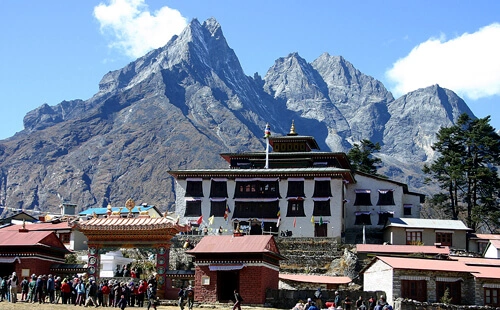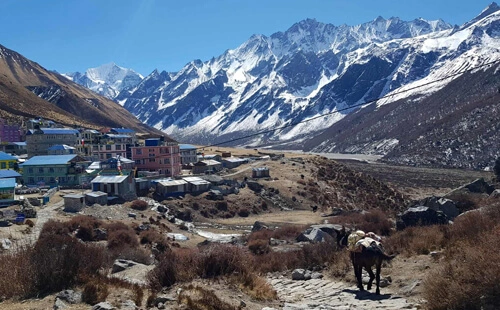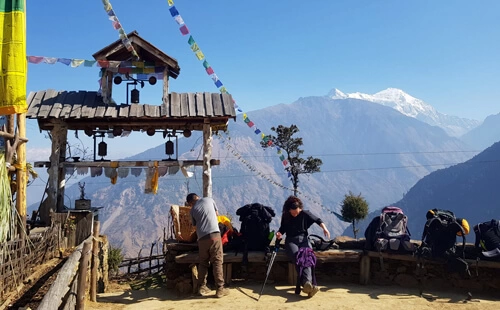What are the factors that affect the cost price of trekking the Annapurna region?
Several factors can influence the overall trip to the Annapurna region, including the type of tour operator (local or international) that you have chosen for your journey, the specific route of your preferences, the type of experience you are seeking in the Annapurna Himalayas, and others.
Nonetheless, here is a breakdown of some of the major elements that can have a direct effect on the budget of your extraordinary excursion to the Annapurna region that you have to put into consideration, whether it is your first-time visit or you are looking for yet another incredible stroll within the Annapurna Conservation Area that looks after the entire Annapurna Himalayan outskirts.
The type of tour operator
In comparison to the local operators, the tours to the Annapurna region offered by international operators tend to be costlier due to the involvement of middlemen in between.
Local tour operators and organizers, such as Adventure Himalayan Travels and Treks, based in Nepal, offer similar comprehensive services to those of international tour organizers at a reasonable price, providing a better insight into the local logistics and resources on the trek to the Annapurna region.
We offer a budgeted trek to a more luxurious expedition to the Annapurna region, where our package cost covers all the essential expenses of the trekking logistics, including the three-star accommodations in Kathmandu and Pokhara, comfortable local teahouses and lodges during the trek days, hearty meals, required permits, and all kinds of transportation used on the way, including domestic flights if needed.
The trek group size
With the banning of free individual trekkers (FITS) in Nepal from April 1st, 2023, solo trekking is legal only when hired by one of the professional guides and can cost slightly more than venturing the Annapurna region in a group.
On group trips to the Annapurna region, you can share the direct and indirect expenses between trekkers, including the hiring of guides and porters, along with other resources such as first aid kits, permits, transportation, accommodation, and other essentials.
Further, numerous tour operators in Nepal offer a group discounted price to go on adventurous expeditions to the Annapurna region for larger groups, decreasing the cost per person as the group size increases, including Adventure Himalaya Travels and Treks, which provides a special discount for trekking groups consisting of more than ten members.
The time of the year you are trekking to the Annapurna region
The Nepalese Himalayas experience two of the peak trekking seasons: spring and autumn, due to their comparatively more favorable weather and route conditions with clear visibility and comfortable hiking days; hence, at these times of the year, there is a high demand for trekking packages, accommodations, and other services, eventually leading to an increase in price.
Whereas the summer and winter seasons of the Annapurna region in Nepal, also referred to as the off-trekking season, observe a notable discounted tour and trekking package to the Annapurna Himalayas that you can fall in love with, along with the true sense of tranquility and more intimate raw Himalayan wilderness. So, you might want to check out:
The type of accommodation and meal option of your preferences
While the whole Annapurna region comes under tea house-based trekking in Nepal, offering comfortable teahouses and local lodges throughout the route, in some parts of the region, luxury lodges, and hotels are also available for upgrading, which can charge you an additional cost than the everyday price of staying at teahouses and local lodges.
Similarly, the teahouses and lodges on the way to the Annapurna region offer standard Nepali and international cuisines such as Dal Bhat (rice and lentils), varieties of noodles, soups, momos, and other simpler dishes, sticking to which is a more cost-effective method, while western-style breakfasts, special dinners, or imported items can be specially priced.
When having a dietary restriction such as vegan, gluten-free, or organic menus, it is advisable to request a prior arrangement that can be done at some additional cost.
Guides and porters for the trip to the Annapurna region
The guides and porters are a must-have travel companion during your journey to the Annapurna region of Nepal, which might expose you to several steep ascents and descents on the rugged trail along with unpredictable weather conditions. The guides and porters can enhance your overall experience to make it more hassle-free.
On the other hand, it adds to the cost of the Annapurna trekking package. How much specifically depends on other factors such as group size and trek duration, while larger and longer treks may require more guides and porters, resulting in higher costs.
It is good to classify at least USD 25 to USD 30 each day to hire a guide, as it can cost you anywhere in between depending on the expertise of the guide according to your preferences in terms of the type of services you are looking forward to, and specific language speaking guides and porter you wish to hire along with your precise needs at service level and Himalayan experiences.
The language specialist's guides and porters, such as Spanish, French, Japanese, Chinese, or any other than English-speaking guides, tend to charge you reasonably more and are hireable from any locally registered trekking company in the hustling and bustling cities of Nepal, Kathmandu, and Pokhara.
If you are looking for one such professional guide who has acquired remarkable knowledge of the local terrains, culture, traditions, and potential risk factors of the Annapurna region, is an excellent navigator, and is a trustworthy travel companion, you can hire a trekking guide with a locally registered trekking company or can contact us for a local Sherpa guide.
Permits and fees to Voyage the Annapurna region
The Annapurna trekking region of Nepal is one of the protected areas of the country that comes under the Annapurna Conservation Area and hence requires at least two permits to enter the area which are the Annapurna Conservation Area Permit (ACAP) and the Trekkers Information Management System (TIMS) card, and hence it is important to budget for these permit expenses as well.
The cost of ACAP ranges from USD 30 to USD 40, while the TIMS card’s fee can cost you USD 10 to USD 20 or USD 6 to USD 10 per person, depending on whether you are going on a solo or group trip and the nationality of the adventure. The revenue generated from these permits contributes to conservation efforts, maintenance of the trekking trail, and tracking of trekkers in need of assistance in any sort of emergency or aid.
Costs of Transportation
The Annapurna trekking region is accessible from both the airways and roadways from Pokhara, which is also known as the gateway to Annapurna. Jomsom, situated on the route to the various trekking trails of the region, has an airport from where you can choose any side trip or exploration of any hidden gems that you prefer.
In this context, an overland tour to the Annapurna region is a more budget-friendly option, while a domestic flight to Jomsom and then a trek are more convenient and comfortable alternatives for travelers and trekkers with limited stays in Nepal or who are specially able individuals.
To conclude, the means of transportation used during the expedition to the Annapurna region of Nepal also plays a vital role in determining the total sum you spent on any package you bought or customized.
The number of trek days to the Annapurna region
Yes, the number of days you have separated for hiking in the Annapurna region has a noticeable effect on the overall package cost you will be spending, as the voyage with more trek days requires similar preparation and booking of accommodation, meals, permits, and possible guides and porters.
Although a long expedition can incur higher costs, it is one of the best ways to incorporate the immense discovery of the hidden natural and cultural beauty of the Annapurna region, along with its diverse landscapes and remote villages with untouched traditional heritages.
Travel Insurance for the trek to the Annapurna region
Travel insurance is your top priority when trekking in the Annapurna region of Nepal to keep yourself in peace of mind. It provides financial security in the unfortunate events of medical emergencies, trek cancellations, delays, helicopter evacuations, or other unforeseen circumstances such as lost or stolen goods.
The exact cost of travel insurance depends upon the age, coverage requirements, and pre-existing or non-existing medical records of the trekkers, and insurance provider; hence, it is always good to get your trip ensured by one of the local insurance companies that you can hold liable.
So, it is crucial to include the cost of travel insurance in your overall expenditures when budgeting for your Annapurna trekking trip, providing you with full coverage to keep yourself financially shielded against any unforeseen crises or delays on your journey.
Your spending habits and miscellaneous expenses
In general, the package cost to trek the Annapurna region includes most of the essential necessities; however, if you decide to get any extra meals, drinks, snacks, bottled water, souvenirs, show gratuities for guides and porters, or include any other optional hot shower or horseback riding, that will come under personal spending, and no doubt it is one of the factors that helps determine the holistic package cost to the Annapurna region.
Similarly, there can be some additional expenses like adding in gear, buying or renting trekking equipment or clothing, medical expenses, or expenses related to side trips or sightseeing that you want to take yourself on outside of the trip itinerary as miscellaneous expenses, which is also a deciding factor in how much the Annapurna region trekking is going to cost overall.
While you can embark on the Annapurna region alone by hiring one of the government-authorized guides, where the porters are optional whether to hire or not but make your journey fulfilling for you at a reasonable package cost as outlined above, Adventure Himalayan Travels and Treks presents you with our top five best-budget treks in the Annapurna Himalayan region to not miss out in the years 2024 and 2025. Which are:
Here, most of the trekking expedition is moderately difficult hiking in the Annapurna region, among which the circuit trip is comparatively longer and can be slightly more expensive than the other medium-duration adventurous rambling, where the Mohare Danda Odyssey stands out as the shortest journey to the Annapurna Himalayas, still guaranteeing no less natural and cultural immersion than any other voyage in Nepal.
We at Adventure Himalayan Travels and Treks are a team of travel and trekking specialists customizing and crafting top-notch itineraries to expedite the beautiful corners of the Himalayas: India, Bhutan, Tibet, and Indonesia, including our home country of Nepal, where we tailor the most fantastic adventure of our lifetime in the heart of the Nepalese Himalayas, including the Annapurna region.
To conclude, the cost of trekking in the Annapurna Himalayan region for 10 to 15 days can range anywhere from USD 500 to USD 1,500 per person, which usually does not include international airfare and travel insurance. To find out the precise cost of your journey, it is wise to consult with local authorities and related travel and trekking agencies or get in touch with Adventure Himalayan Travel and Treks.




